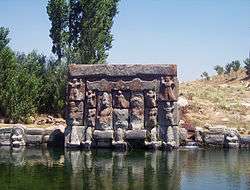Beyşehir
Beyşehir (pronounced [ˈbejʃeˌhiɾ]) is a large town and district of Konya Province in the Akdeniz region of Turkey. The town is located on the southeastern shore of Lake Beyşehir and is marked to the west and the southwest by the steep lines and forests of the Taurus Mountains, while a fertile plain, an extension of the lake area, extends in the southeastern direction. According to 2000 census, the population of the district is 118,144 of which 41,312 live in the town of Beyşehir.[3][4]
Beyşehir | |
|---|---|
Town | |
Taşköprü ("Stone Bridge"), a historical regulator dam and bridge in Beyşehir. | |
 Beyşehir Location of Beyşehir | |
| Coordinates: 37°41′N 31°44′E | |
| Country | |
| Region | Akdeniz |
| Province | Konya |
| Government | |
| • Mayor | Murat ÖZALTUN (AKP) |
| Area | |
| • District | 2,116.29 km2 (817.10 sq mi) |
| Elevation | 1,205 m (3,953 ft) |
| Population (2012)[2] | |
| • Urban | 35,872 |
| • District | 69,739 |
| • District density | 33/km2 (85/sq mi) |
| Time zone | UTC+2 (EET) |
| • Summer (DST) | UTC+3 (EEST) |
| Postal code | 42700 |
| Licence plate | 42 |
| Climate | Csa |
| Website | www.beysehir.bel.tr |

History
The Hittite monument situated in Beyşehir's depending locality of Eflatunpınar, at a short distance to the northeast from the town, proves that the Hittite Empire had reached as far as the region, marking in fact, in the light of present knowledge, the limits of their extension to the southwest. Evidence points out that an earlier settlement, perhaps dating back to the Neolithic Age, was also located in Eflatunpınar. Another important early settlement was located in Erbaba Höyük, situated 10 km (6 mi) to the southwest of Beyşehir, and which was explored by the Canadian archaeologists Jacques and Louise Alpes Bordaz in the 1970s, leading to finds from three neolithic building layers.
The Beyşehir region corresponds to classical antiquity's Pisidia. At the location of the town itself there was in all likelihood a Greek city, which in one view was probably named Karallia, which was one of the two urban centers that surrounded the lake at the time, and in Roman times was known as Claudiocaesarea (Greek: Κλαυδιοκαισάρεια, Klaudiokaisareia), and Mistheia (Greek: Μίσθεια) in Byzantine times. Another theory is that Beyşehir's site corresponds to that of Casae (Κἀσαι), the seat of a Christian diocese of the Roman province of Pamphylia, which under Roman rule included large parts of Pisidia.[5][6] The names of some of its bishops are given in documents concerning church councils held from 381 to 879.[7][8] No longer a residential bishopric, Casae in Pamphylia is today listed by the Catholic Church as a titular see.[9]
The state of desolation into which the ancient city, whatever it was called, had fallen by the first decades of the 13th century is suggested by the name "Viranşehir" that the Seljuk Turks had given to the town, meaning "the desolate city". The Seljuk Sultans of Rum based in Konya nevertheless built their summer residence nearby, in an agglomeration situated on the southwestern lake shore at a distance of 80 km (50 mi) from Beyşehir city, and which came to be known as Kubadabad Palace. While the most precious finds of Kubadabad site date from the reign of Alaeddin Keykubad (1220–1237), it was a seasonal settlement area chosen by and for the sultans already in the late 12th century.
After the fall of the Seljuks, Viranşehir was renamed for a time as Süleymanşehir in honor of one of the beys of the region's ruling dynasty, the Eshrefids, who made the town into his capital. Since the beys of Eshrefids resided here, the present name of Beyşehir was gradually adopted for the town. The Great Mosque of Beyşehir built by the dynasty between 1296–1299, also called Eşrefoğlu Mosque, is considered one of the masterpieces of the intermediate period of Anatolian beyliks between the Seljuk and Ottoman architecture styles.
See also
- Eşrefoğlu Mosque, 13th-century mosque
- Lake Beyşehir, Turkey's third biggest lake, and the biggest freshwater lake.
- Kubadabad Palace
- Eflatunpınar, a spring with a monument by Hittites inside the nearby Lake Beyşehir National Park.
- Taşköprü, a historic regulator dam and pedestrian bridge
Notes
- "Area of regions (including lakes), km²". Regional Statistics Database. Turkish Statistical Institute. 2002. Retrieved 2013-03-05.
- "Population of province/district centers and towns/villages by districts - 2012". Address Based Population Registration System (ABPRS) Database. Turkish Statistical Institute. Retrieved 2013-02-27.
- Turkish Statistical Institute. "Census 2000, Key statistics for urban areas of Turkey" (in Turkish). Archived from the original (XLS) on 2007-09-27. Retrieved 2008-03-23.
- GeoHive. "Statistical information on Turkey's administrative units". Archived from the original on 2007-10-19. Retrieved 2015-04-08.
- Encyclopædia Britannica, "Pamphylia"
- Charles Anthon, A Classical Dictionary (Harper and Bros. 1845), p. 1067
- Michel Lequien, Oriens christianus in quatuor Patriarchatus digestus, Paris 1740, Vol I, coll. 1005-1006
- Pius Bonifacius Gams, Series episcoporum Ecclesiae Catholicae, Leipzig 1931, p. 450
- Annuario Pontificio 2013 (Libreria Editrice Vaticana 2013 ISBN 978-88-209-9070-1), p. 860
References
- Falling Rain Genomics, Inc. "Geographical information on Beyşehir, Turkey". Retrieved 2008-03-23.
External links
| Wikimedia Commons has media related to Beyşehir. |
